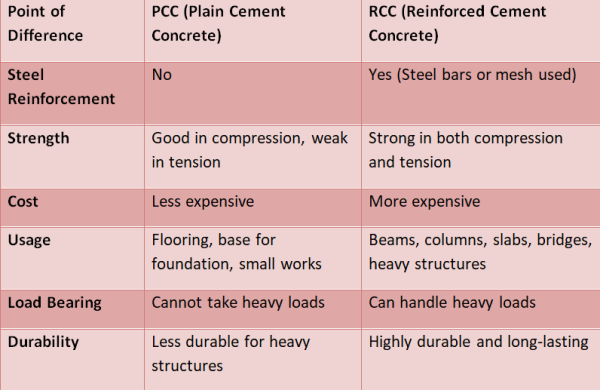
When it comes to building strong and durable structures, two of the most commonly used materials in the construction industry are:
RCC (Reinforced Cement Concrete) and
PCC (Plain Cement Concrete).
While both play crucial roles in construction, They are used for different purposes based on their properties, strength, and requirements.
In this blog post, we will understand what RCC and PCC are, their uses, key differences, and why both are essential in Civil Engineering.
What is PCC?
PCC means Plain Cement Concrete. It is a mixture of cement, sand, small stones (aggregates) and water. There is no steel or iron (reinforcement) used in it. PCC is mostly used to prepare a flat and strong surface before starting the main construction work.
Where is PCC Used?
PCC is mainly used to make a flat, strong, and level surface before starting construction work. It is commonly used under the foundation of buildings, in house flooring, small roads, footpaths and to level uneven ground before construction.
Materials Used in PCC:
PCC (Plain Cement Concrete) is made by mixing cement, sand, stones or gravel, and water. It does not have any steel or iron in it.
Benefits of PCC:
Simple and easy to use.
Low cost.
Gives a strong and smooth surface.
Protects building foundations from moisture and soil.
Limitations of PCC:
Not suitable for heavy loads.
Cannot resist bending or pulling forces.
Can crack easily if heavy weight is applied.
PCC provides a strong and level base for construction work. It is simple, affordable and mostly used where heavy strength is not required.
What is RCC?
RCC means Reinforced Cement Concrete. It is a mixture of cement, sand, stones, and water, but the important addition in RCC is steel bars (iron rods) or mesh. These steel bars give extra strength to the concrete, so it can handle heavy loads and bending forces.
Materials Used in RCC:
RCC (Reinforced Cement Concrete) is made by mixing cement, sand, stones or gravel, water, and steel rods or mesh. The steel is added to make the concrete stronger so it can handle heavy loads and pressure.
Where is RCC Used?
RCC is mostly used in the main parts of a building like beams, columns, roof slabs, and walls. It is also used in making bridges, flyovers, water tanks, tall buildings, and strong foundations where extra strength is needed.
Benefits of RCC:
Very strong and durable.
Can handle heavy loads.
Can resist bending, pulling, and twisting forces.
Suitable for big and tall buildings.
Limitations of RCC:
Cost is higher than PCC.
Needs skilled workers for construction.
Takes more time to prepare and build.
Requires proper curing (watering) for strength.
In short, RCC is widely used in modern construction for its high strength and durability. It is best for heavy load structures like buildings, bridges, and slabs.
Main Difference Between RCC and PCC
RCC and PCC are both used in construction but serve different purposes. Here are the key differences between RCC and PCC:

Both RCC and PCC have their own importance in construction depending on the requirement of the structure. Choosing the right material ensures the safety, strength, and durability of any building.
Conclusion
Both RCC and PCC are essential parts of any construction project. While PCC is used to provide a stable and clean surface for construction, RCC is the structural core of buildings and infrastructure.
Knowing the difference between RCC and PCC is crucial for every Civil Engineer in Los Angeles, site supervisor, and construction worker. It helps in using the right material at the right place, ensuring safety, strength, and durability of the structure.
Remember, PCC is for preparation, and RCC is for protection and strength.
===================================================================
Title: Key Differences Between RCC and PCC in Construction
Des: Know the difference between RCC and PCC in construction. Learn their meaning, uses, materials, & why both are important for building strong and safe structures.

